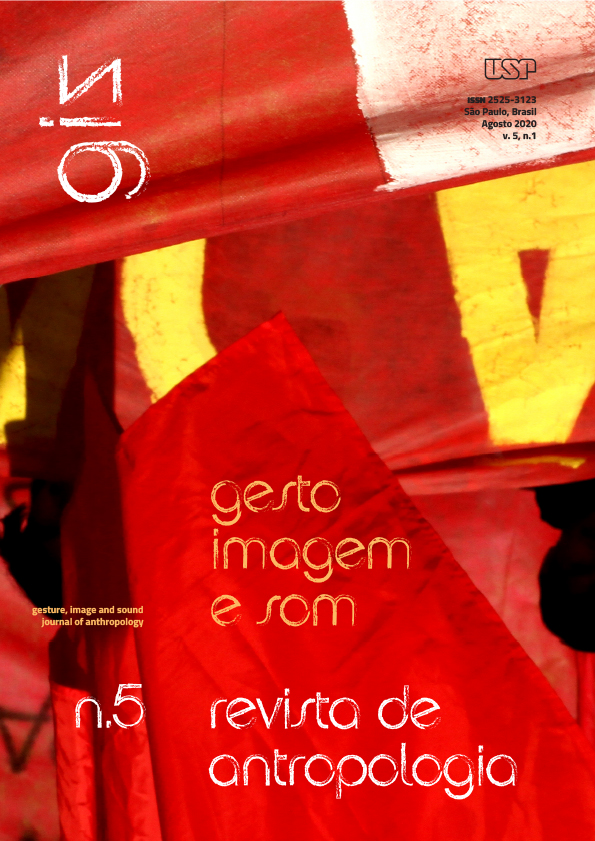The anthropologist filmmaker and the native actor/author: transformations of Oumarou Ganda and Petit Touré in Moi, un noir, by Jean Rouch
DOI:
https://doi.org/10.11606/issn.2525-3123.gis.2020.165057Keywords:
Jean Rouch, Performance, Body, Native, AuthorAbstract
This article presents an analysis of the performatic and bodily dimension of Oumaru Ganda’s and Petit Touré’s characters in Moi, un noir, by Jean Rouch (1958). More than analyzing camera angles, character speeches and editing, it is proposed to emphasize the interpretation of the performatic dimension, looking at bodily gestures and facial expressions, as well as at Omarou Ganda’s and Petit Touré’s voice-off impostation. On the one hand, understanding how performatic and bodily dimensions of Ganda and Touré create a particular mise-en-scène enables us to view them as native actors/authors. On the other hand, analyzing the spaces available for Ganda’s and Touré’s creative interventions in the filmmaking will bring new aspects to the considerations on the construction of anthropological knowledge, through the relation between Rouch and his interlocutors.
Downloads
References
Arnheim, Rudolf. 1957. Film as art. Berkeley: University of California Press.
Baron, Cynthia and Sharon Marie Carnicke. 2008. Reframing screen performance. Ann Arbor: University of Michigan Press.
Bazin, André. 2006. Orson Welles. Rio de Janeiro: Zahar.
Bazin, André. 2018. O que é o cinema? São Paulo: Ubu.
Benjamin, Walter. 1987. A obra de arte na época de sua reprodutibilidade técnica. In Magia, técnica, arte e política: ensaios sobre literatura e história da cultura, Walter Benjamin, 167-196. São Paulo: Brasiliense.
Bhabha, Homi. 2007. O local da cultura. Belo Horizonte: Ed. UFMG.
Boudreault-Founier, Alexandrine, Rose Satiko Gitirana Hikiji e Sylvia Caiuby Novaes. 2016. Etnoficção: uma ponte entre fronteiras. In A experiência da imagem na etnografia, ed. Andrea Barbosa, Edgar Teodoro da Cunha, Rose Satiko Gitirana Hikiji e Sylvia Caiuby Novaes, 37-58. São Paulo: Terceiro Nome.
Deleuze, Gilles e Claire Parnet. 1998. Diálogos. São Paulo: Escuta.
Eisenstein, Sergei.1957. The film sense. New York: Meridian Books.
Ferraz, Ana Lúcia M. C. 2013. Dramaturgia da vida social e a dimensão patética da pesquisa antropológica: o cinema de Jean Rouch e a prática de realização de filmes etnográficos. In Antropologia e performance: ensaios Napedra, org. John Cowart Dawsey, Rose Satiko Gitirana Hijiki, Marianna Monteiro e Regina Polo Muller, 323-338. São Paulo: Terceiro Nome.
Gonçalves, Marco Antonio. 2008. O real imaginado: etnografia, cinema e surrealismo em Jean Rouch. Rio de Janeiro: Topbooks.
Grimshaw, Anna. 2001. The ethnographer’s eye: ways of seeing in anthropology. Cambridge: Cambridge University Press.
Hall, Stuart, org. 1997. Representation: cultural representation and signifying practices. London: Sage.
Henley, Paul. 2009. The adventure of the Real: Jean Rouch and the Craft of Ethnographic Cinema. Chicago, London: University of Chicago Press.
Hirano, Luis Felipe Kojima. 2019. Grande Otelo: um intérprete do cinema e do racismo no Brasil (1917-1993). Belo Horizonte: Ed. UFMG.
Hirano, Luis Felipe Kojima. 2013. O imaginário da branquitude à luz da trajetória de Grande Otelo: raça, persona e estereótipo em sua perfomance artística. Afro-Ásia, no. 48: 77-125. http://dx.doi.org/10.1590/S0002-05912013000200003.
Ingold, Tim. 2007. Lines. London: Routledge.
Ingold, Tim. 2015. The life of lines. London: Routledge.
King, Barry. 1985. Articulating Stardom. Screen, vol. 26, no. 5: 27-50.
Kuleshov, Lev. 1974. Kuleshov on film: writings of Lev Kuleshov. Los Angeles: University of California Press.
Lotierzo, Tatiana. 2019. Erosão num pedaço de papel. Tese de doutorado, Universidade de Brasília, Brasília.
Marcus, George. 1991. Identidades passadas, presentes e emergentes: requisitos para etnografias sobre a modernidade no final do século XX ao nível mundial. Revista de Antropologia, vol. 34: 197-221. https://doi.org/10.11606/2179-0892.ra.1991.111301.
Mauss, Marcel. 1934/2003. As técnicas do corpo. In: Ensaios de sociologia e antropologia. São Paulo: Cosac Naify.
Piault, Marc-Henri.1997. Uma antropologia-diálogo: a propósito do filme de Jean Rouch, Moi, un noir. Cadernos de Antropologia e Imagem, no. 4: 185-192.
Pirandello, Luigi. 1925. On tour. Paris: Sagittaire.
Stam, Robert e Ella Shohat. 2006. Crítica da imagem eurocêntrica. São Paulo: Cosac Naify.
Strathern, Marilyn. 2013. Fora de contexto. São Paulo: Terceiro Nome.
Strathern, Marilyn. 1982. The limits of autoanthropology. In Anthropology at home, ed. Anthony Jackson, 16-37 London: Tavistock Publications.
Sztutman, Renato. 2004. Jean Rouch: um antropólogo-cineasta. In Escrituras da imagem, ed. Sylvia Caiuby Novaes, Andréa Barbosa, Edgar Teodoro da Cunha, Florencia Ferrari, Renato Sztutman e Rose Satiko Gitirana Hikiji, 49-62 São Paulo: Edusp.
Sztutman, Renato. 2005. Imagens perigosas: a possessão e a gênese do cinema de Jean Rouch. Cadernos de Campo, vol. 13, no. 13: 115-124. https://doi.org/10.11606/issn.2316-9133.v13i13p115-124.
Viveiros de Castro, Eduardo. 2002. O nativo relativo. Mana, vol. 8, no. 1: 113-148. https://dx.doi.org/10.1590/S0104-93132002000100005.
Xavier, Ismail. 2005. O discurso cinematográfico. São Paulo: Paz e Terra.
REFERÊNCIAS AUDIOVISUAIS
Ferraz, Ana Lúcia, Edgar Teodoro da Cunha, Paula Morgado e Renato Sztutman. 2000.
Jean Rouch: subvertendo fronteiras. São Paulo, Brasil, NTSC, cor, 41’, DVD.
Kurosawa, Akira. 1954/2004. Os sete samurais. São Paulo, Brasil, Silverscreen, P&B, 207’, DVD.
Rouch, Jean. 1958/2006. Eu, um negro. Rio de Janeiro, Brasil, VideoFilmes, cor, 78’, DVD.
Sturges, John. 1960/2007. The magnificent seven. Los Angeles, EUA, United Artists, P&B, 128’, DVD.
Truffaut, François. 1959/2003. Os incompreendidos. São Paulo, Brasil, MK2, P&B, 100’, DVD.
Downloads
Published
Issue
Section
License
Authors who publish in this journal agree to the following terms:
a. All rights reserved for authors. Journal has right to first publication. Work is simultaneously licensed under Creative Commons Attribution License which permits sharing work with recognition of authorship and initial publication in this journal for non-commercial ends.
b. Authors are authorized to separately make additional contracts for non-exclusive distribution of version of work published in this journal (e. g. publish in institutional repository or as book chapter), with recognition of authorship and initial publication in this journal.







